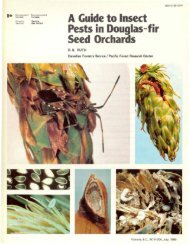the translocation of minerals in trees - Canadian Forest Service
the translocation of minerals in trees - Canadian Forest Service
the translocation of minerals in trees - Canadian Forest Service
Create successful ePaper yourself
Turn your PDF publications into a flip-book with our unique Google optimized e-Paper software.
solutions and determ<strong>in</strong><strong>in</strong>g <strong>the</strong> m<strong>in</strong>eral content <strong>of</strong> plant tissues by ash<strong>in</strong>g are two<br />
important methods for determ<strong>in</strong><strong>in</strong>g m<strong>in</strong>eral requirements and plant reactions<br />
to deficiencies.<br />
Biddulph (1953) considers that reactions <strong>in</strong>volv<strong>in</strong>g <strong>the</strong> precipitation <strong>of</strong><br />
certa<strong>in</strong> m<strong>in</strong>eral nutrients <strong>in</strong> <strong>the</strong> xylem extremities may be respon ible for <strong>the</strong><br />
failure <strong>of</strong> delivery <strong>of</strong> some <strong>m<strong>in</strong>erals</strong> to <strong>the</strong> leaf mesophyll. Such elements as<br />
z<strong>in</strong>c and iron form <strong>in</strong>soluble precipitates with phosphorus. Rediske (1950)<br />
has shown deposition <strong>of</strong> radioiron <strong>in</strong> <strong>the</strong> ve<strong>in</strong>s <strong>of</strong> bean leaves by creat<strong>in</strong>g particular<br />
pH and phosphorus levels with<strong>in</strong> <strong>the</strong> nutrient solution, namely pH 7·0, 0·0001 M<br />
phosphorus and 1 ppm iron. At higher phosphorus levels, iron was largely<br />
precipitated <strong>in</strong> <strong>the</strong> roots and little entered <strong>the</strong> aerial parts. The nutrient<br />
conditions effect<strong>in</strong>g this were pH 7·0, 0·001 M phosphorus and 1 ppm iron.<br />
With nutrient solution at pH 4·00 but o<strong>the</strong>r conditions as first mentioned, <strong>the</strong><br />
leaves were a healthy green <strong>in</strong>dicat<strong>in</strong>g a normal upply <strong>of</strong> iron.<br />
Certa<strong>in</strong> elements have a characteristic distribution <strong>in</strong> plants. Some, like<br />
phosphorus, are freely mobile with<strong>in</strong> <strong>the</strong> plant so that a supply ab orbed early<br />
<strong>in</strong> <strong>the</strong> season may be utilized elsewhere <strong>in</strong> <strong>the</strong> plant when none is available to<br />
<strong>the</strong> roots. Sulphur behaves similarly. Calcium is different from phosphorus<br />
and sulphur <strong>in</strong> that it i usually deposited and <strong>the</strong> part which is absorbed earlier<br />
is <strong>of</strong> no value for later new growth. Iron is like calcium, although a very pronounced<br />
absorption <strong>in</strong> <strong>the</strong> roots may be released later to newly grow<strong>in</strong>g part .<br />
Movement <strong>of</strong> <strong>m<strong>in</strong>erals</strong> from leaves to o<strong>the</strong>r parts <strong>of</strong> <strong>the</strong> plant may be followed<br />
by trac<strong>in</strong>g a radioisotope which was applied to a leaf. The conditions which<br />
control movement <strong>of</strong> <strong>m<strong>in</strong>erals</strong> from mature leaves vary with <strong>the</strong> element studied.<br />
Phosphorus and sulphur move out freely and are little affected by <strong>the</strong> nutrient<br />
conditions <strong>of</strong> <strong>the</strong> plant prior to, or dur<strong>in</strong>g, <strong>the</strong> experimental period. Iron,<br />
calcium, and z<strong>in</strong>c ord<strong>in</strong>arily move from <strong>the</strong> leaf <strong>in</strong> very small amounts and can<br />
be fur<strong>the</strong>r immobilized by a high concentration <strong>of</strong> pho phorus <strong>in</strong> <strong>the</strong> tissues <strong>of</strong><br />
plants grown at pH 7·0 or above.<br />
Biddulph (1951) <strong>in</strong>troduced water made with tritium <strong>in</strong> which phosphorus32<br />
was dissolved, directly <strong>in</strong>to <strong>the</strong> leaves, and <strong>the</strong>n isolated <strong>the</strong> two radioactive<br />
components <strong>in</strong> <strong>the</strong> stem and root tissues below <strong>the</strong> po<strong>in</strong>t <strong>of</strong> <strong>in</strong>troduction. No<br />
marked movement <strong>of</strong> <strong>the</strong> water took place <strong>in</strong> <strong>the</strong> phloem tis ue <strong>of</strong> <strong>the</strong> stem, but<br />
<strong>the</strong> phosphorus32 <strong>in</strong>troduced with <strong>the</strong> tritiated water moved freely. He considers<br />
<strong>the</strong> mechanism <strong>of</strong> <strong>translocation</strong> <strong>of</strong> <strong>m<strong>in</strong>erals</strong> <strong>in</strong> <strong>the</strong> phloem not simple diffusion<br />
<strong>in</strong>ce it is activated <strong>in</strong> some manner to atta<strong>in</strong> speeds approach<strong>in</strong>g three feet<br />
per hour.<br />
The roots require <strong>m<strong>in</strong>erals</strong> for <strong>the</strong>ir growth and consequently compete for<br />
elements which are to be translocated to <strong>the</strong> aerial parts. Biddulph (1953)<br />
<strong>in</strong>vestigated this aspect <strong>of</strong> retention and transport by <strong>the</strong> root for phosphorus<br />
and rubidium. This study extended over a 24-hour period so that diurnal<br />
variations <strong>in</strong> both retention and <strong>translocation</strong> were evident. The <strong>translocation</strong><br />
cycle wa found to be light-sensitive as well as to possess an <strong>in</strong>herent cyclic<br />
phase <strong>in</strong>dependent <strong>of</strong> light.<br />
Bu gen and Munch (1929) state that <strong>trees</strong> obta<strong>in</strong> <strong>the</strong>ir supply <strong>of</strong> <strong>m<strong>in</strong>erals</strong><br />
at different periods <strong>in</strong> <strong>the</strong> grow<strong>in</strong>g season. Larch and p<strong>in</strong>e take up most <strong>of</strong> <strong>the</strong>ir<br />
potassium from mid-June to mid-September, while spruce supplies itself with<br />
this element from mid-May to mid-June. The larch shows light absorption<br />
<strong>of</strong> phosphorus <strong>in</strong> summer and a great absorption <strong>in</strong> autumn, while p<strong>in</strong>e absorbs<br />
phosphorus exclusively <strong>in</strong> late summer, and spruce only <strong>in</strong> <strong>the</strong> spr<strong>in</strong>g and early<br />
ummer. Ramann and Bauer (1912) showed a corre pond<strong>in</strong>g behaviour for<br />
nitrogen <strong>in</strong> <strong>the</strong>se species and considered it a reason for <strong>the</strong> success <strong>of</strong> mixedwoods<br />
as compared to pure stands.



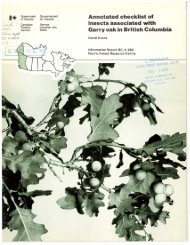
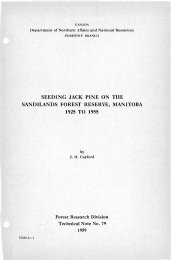
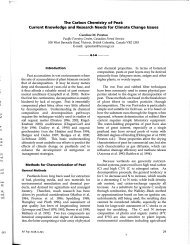


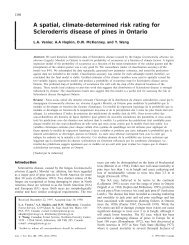

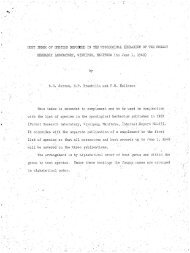
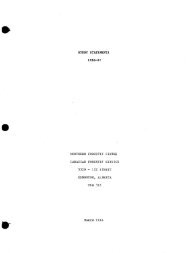
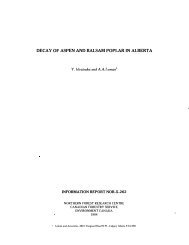
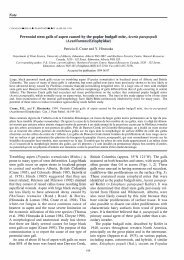
![Po],rell](https://img.yumpu.com/11946277/1/190x231/porell.jpg?quality=85)
